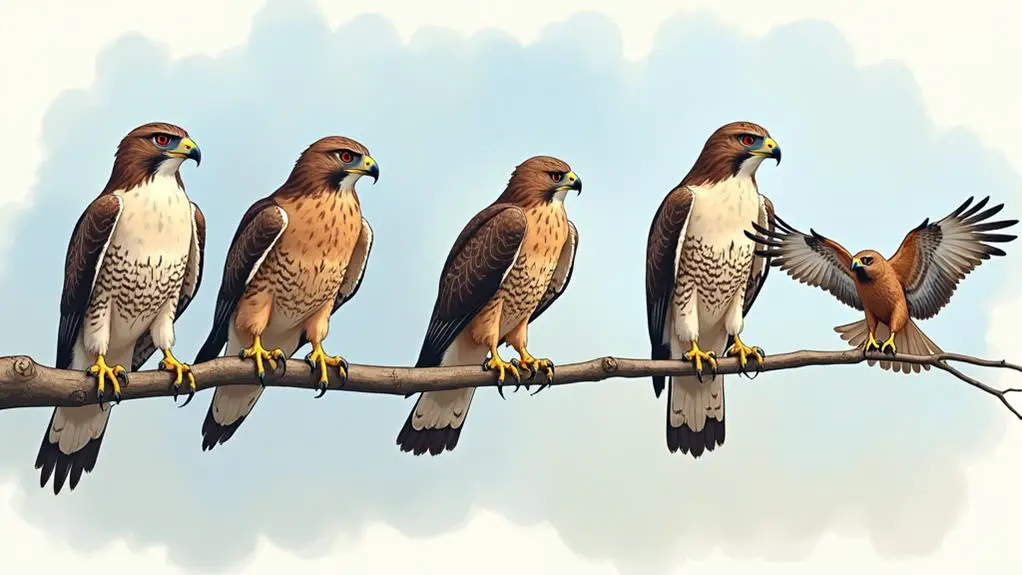As you venture into Illinois' diverse landscapes, you'll likely catch a glimpse of a hawk soaring overhead or perched atop a tree. But which species is it? With several hawks calling the state home, it's essential to know what sets them apart. From the sharp, hooked beak of the Red-tailed Hawk to the piercing gaze of the Cooper's Hawk, each species boasts unique physical characteristics that can aid in identification. But that's just the beginning – their habitats, migrations, and hunting behaviors also hold crucial clues. Can you distinguish between a hawk's cry and its wingbeat pattern?
Key Takeaways
- Hawks in Illinois vary in size, shape, and color, with species like Red-tailed and Cooper's Hawks having distinct physical features.
- Habitat choices depend on species, with woodland edges, urban sites, and forest fragmentation providing varied hunting grounds and nesting sites.
- Migration patterns differ among species, such as Broad-winged Hawks making a notable fall migration to Central and South America.
- Hawks exhibit unique hunting behaviors, including perch-hunting, soaring, dive-bombing, stalking, and scavenging, adapted to their environment and prey.
- Breeding, courtship, and nesting habits vary among species, with factors like nest site selection, breeding season timing, and aerial displays playing crucial roles.
Physical Characteristics of Hawks
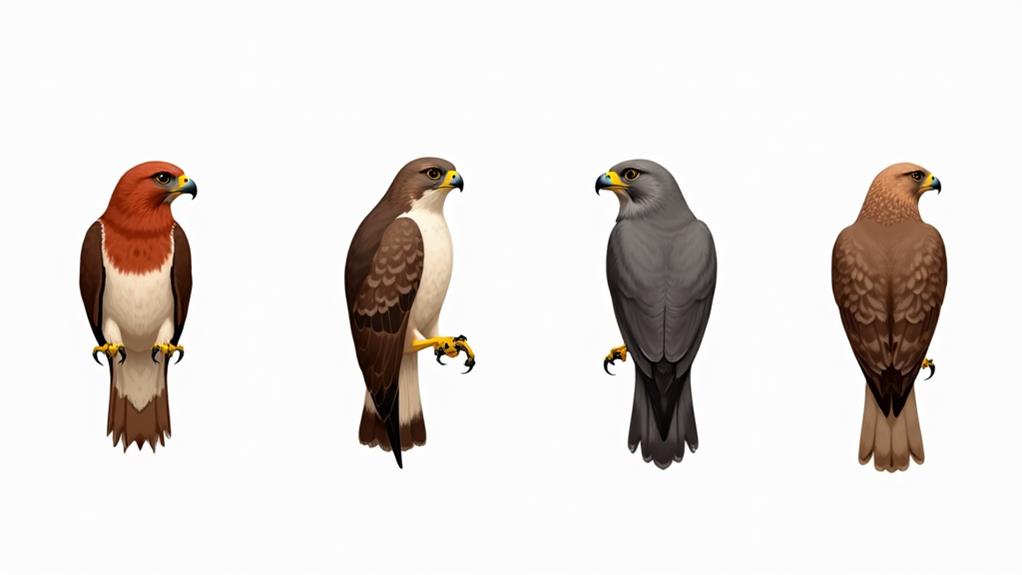
Hawks, being birds of prey, have evolved to possess distinct physical features that enable them to thrive in their hunting environment.
You'll notice that hawks have strong, muscular bodies, typically ranging in length from 18 to 60 inches, with a wingspan of up to 5 feet. Their wings are broad and rounded, allowing for agile flight and precision maneuverability.
Upon closer inspection, you'll observe that hawks have beak shape variations, adapted to their specific diets.
For example, the Red-tailed Hawk's strong, hooked beak is ideal for tearing flesh, while the Swainson's Hawk's shorter, more rounded beak is better suited for catching insects.
Additionally, hawks exhibit eye color differences, which may indicate their species, age, or sex.
The Red-shouldered Hawk, for instance, has dark brown eyes, whereas the Cooper's Hawk has a piercing orange-red eye color.
Habitat and Distribution Patterns
You'll find hawks in Illinois occupying woodland edge habitats, where they capitalize on the abundance of small mammals and songbirds.
They also adapt to urban nesting sites, such as city parks and buildings, offering a unique opportunity for human-hawk coexistence.
As you explore the state's landscape, you'll notice hawks favoring areas with a mix of open spaces and vertical structures.
Woodland Edge Habitats
In woodland edge habitats, certain characteristics create an ideal environment for hawks to thrive. You'll often find these areas where forests meet open spaces, such as fields or pastures. The unique combination of tree cover and open areas provides hawks with ample space to hunt and roost.
| Habitat Characteristic | Description | Hawk Benefit |
|---|---|---|
| Forest fragmentation | Small, isolated forest patches | Increases habitat diversity, providing varied hunting grounds |
| Edge effects | Transition zones between forest and open areas | Offers perches for hunting and surveillance |
| Structural complexity | Mix of tree species, ages, and densities | Provides nesting sites and shelter from harsh weather |
As you explore woodland edge habitats, keep in mind that hawks are adapted to exploit these unique conditions. Forest fragmentation, for instance, creates a mosaic of habitats that hawks can navigate with ease. Edge effects, meanwhile, allow hawks to capitalize on the abundance of prey species that thrive in these transition zones. By understanding these habitat characteristics, you'll be better equipped to identify the hawks that call Illinois home.
Urban Nesting Sites
While woodland edge habitats provide ideal conditions for hawks, urban environments also harbor suitable nesting sites.
You'll find that buildings, bridges, and other urban structures can mimic the characteristics of trees, providing elevated perches and nest sites.
In fact, some hawk species have adapted to urbanization, exploiting the abundance of food and shelter in these areas.
When scouting for urban nesting sites, look for buildings with flat or slightly pitched roofs, as these can serve as surrogate tree canopies.
Building codes often require structures to have a minimum number of trees or green spaces, which can inadvertently create habitat for hawks.
You may spot hawks nesting on roof tops, particularly in areas with low to moderate building density.
Pay attention to buildings with ornate architectural features, such as ledges or chimneys, which can provide sheltered nesting sites.
Migration and Movement Patterns
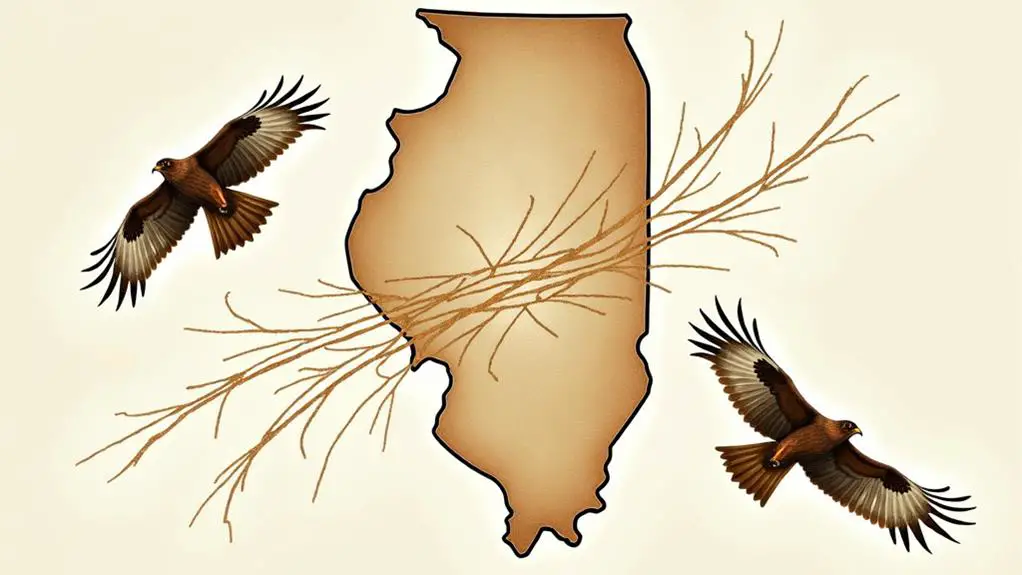
Several species of hawks in Illinois exhibit distinct migration and movement patterns, which are crucial for survival and breeding.
You'll notice that these patterns vary depending on the species. For instance, the Broad-winged Hawk, a common migrant in Illinois, makes a notable fall migration to its winter ranges in Central and South America. During this journey, they fly in large kettles, often reaching thousands of birds.
In contrast, the Red-tailed Hawk, a year-round resident in Illinois, makes altitudinal movements in response to changes in food availability and temperature.
You may observe that some hawks in Illinois are partial migrants, with only certain populations making short-distance movements. The American Kestrel, for example, migrates from its breeding grounds in northern Illinois to its winter ranges in the southern part of the state.
Understanding these migration and movement patterns can help you identify the species you're observing and appreciate their remarkable adaptations to their environment. By recognizing these patterns, you'll become a more informed and skilled hawk enthusiast in Illinois.
Hunting and Feeding Behaviors
You're likely to observe hawks in Illinois employing a range of hunting strategies, tailored to their specific prey and environment.
These birds of prey have evolved to be efficient predators, and their hunting behaviors are a testament to their adaptability and cunning.
When it comes to prey selection, hawks in Illinois tend to focus on small to medium-sized mammals, such as rodents, rabbits, and hares.
They also prey on birds, reptiles, and amphibians.
- Perch-hunting: Hawks perch in trees or on power lines, scanning the ground below for unsuspecting prey.
- Soaring and scanning: They soar overhead, scanning the landscape for signs of prey, using their exceptional eyesight to spot potential targets.
- Dive-bombing: Hawks tuck their wings and dive at incredible speeds to catch prey off guard.
- Stalking: They stalk their prey on foot, using cover and stealth to get close before striking.
- Scavenging: Hawks will also scavenge for carrion, taking advantage of easy meals when they come along.
Understanding these hunting strategies and prey selection habits can help you better appreciate the complex and fascinating world of Illinois hawks.
Nesting and Breeding Habits
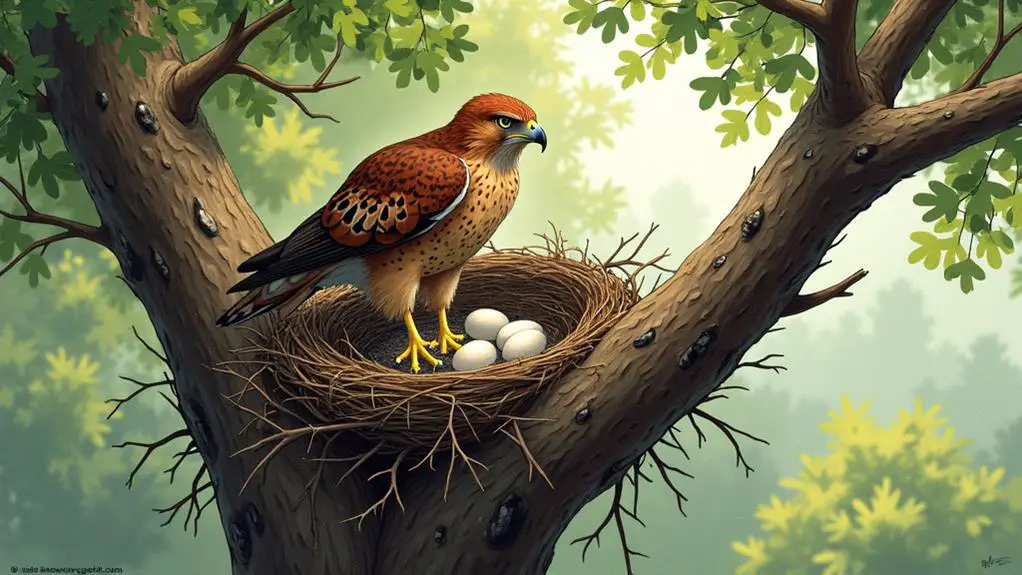
You'll observe that hawks in Illinois exhibit specific preferences when selecting nest sites, with trees and utility poles being common choices.
The timing of the breeding season also plays a crucial role, with most hawks forming pairs in February or March.
As you explore the nesting habits of these birds, you'll discover that they tend to favor habitats with minimal human disturbance and abundant food sources.
Nest Site Selection
When scouting for a nest site, Illinois hawks prioritize locations that offer protection from harsh weather and potential predators, while also providing a clear flight path and proximity to hunting grounds.
You'll often find them selecting sites with specific characteristics that ensure their young have the best chance of survival.
Some of the preferred nest site features include:
- Tree cavities: especially those in dead or dying trees, which provide natural protection from the elements
- Cliff ledges: offering a secure perch and clear visibility of the surrounding area
- Utility poles: tall structures that provide a safe distance from ground predators
- Transmission towers: similar to utility poles, these offer a high vantage point and protection from predators
- Abandoned nests: hawks may reuse nests built by other birds, such as crow or owl nests, if they're in good condition and meet their site selection criteria
Breeding Season Timing
With their nest sites selected, Illinois hawks turn their attention to breeding and nesting.
During this period, you'll observe a distinct shift in their behavior, marked by the onset of mating rituals.
These rituals typically involve aerial displays, such as soaring, diving, and talon-locking, which help strengthen pair bonds and establish dominance.
In Illinois, the breeding season typically falls within a specific window, ranging from late February to early May.
During this time, hawks will engage in intense courtship activities, including vocalizations, gift-giving, and displays of aggression.
As the breeding window narrows, mating rituals become more frequent and intense, culminating in copulation.
It's essential to note that the timing of the breeding season can vary depending on factors such as food availability, weather conditions, and geographic location within the state.
Nesting Habitat Choices
Across Illinois's diverse landscapes, hawks exhibit a strong affinity for specific nesting habitats, carefully selecting sites that provide optimal shelter, protection, and access to resources.
As you explore the state's varied environments, you'll notice that hawks tend to favor certain characteristics when choosing a nesting site.
- Tree cavities: Hawks often occupy natural cavities in trees, especially those with dense foliage or overhanging branches that conceal the nest.
- Abandoned nests: They may also take over nests abandoned by other birds, such as old crow or owl nests, which can provide a convenient and secure starting point.
- Upland forests: Hawks tend to prefer upland forests with mature trees, which offer better protection from harsh weather and potential predators.
- Woodland edges: The transition zones between forests and open areas, like fields or meadows, can also provide ideal nesting sites, as they offer a mix of cover and visibility.
- Utility poles: In some cases, hawks may even nest on utility poles, taking advantage of the elevated position and relative safety from ground-dwelling predators.
Size and Shape Variations
The variations in size and shape among hawks in Illinois are crucial to understanding their adaptability and survival strategies. You'll notice that different species have distinct body masses and wing proportions, which impact their flight patterns, hunting styles, and overall ecological niches.
| Species | Body Mass (g) | Wing Proportions (cm) |
|---|---|---|
| Red-tailed Hawk | 1000-1500 | 120-140 |
| Cooper's Hawk | 200-400 | 90-110 |
| Broad-winged Hawk | 300-500 | 100-120 |
| American Kestrel | 100-200 | 60-80 |
| Rough-legged Hawk | 600-1000 | 130-150 |
When you observe hawks in the wild, pay attention to these physical characteristics. For instance, the Red-tailed Hawk's larger body mass and longer wing span allow it to soar for extended periods, scanning for prey from high altitudes. In contrast, the Cooper's Hawk's smaller size and more compact wings enable it to pursue prey through dense vegetation. By recognizing these size and shape variations, you'll better understand the unique adaptations of each species and improve your hawk identification skills.
Plumage and Coloration Differences
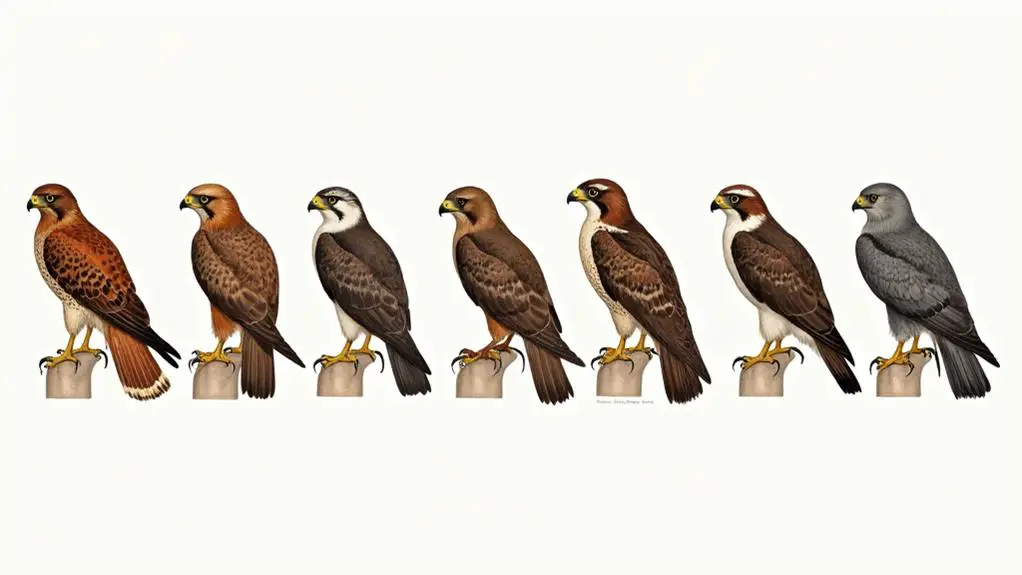
You've observed the size and shape variations among Illinois hawks, which significantly impact their ecological niches.
Now, let's dive into the plumage and coloration differences that set these birds apart.
When it comes to identifying hawks, understanding their molt patterns and feather textures is crucial.
- Molt patterns: Red-shouldered hawks undergo a partial molt, replacing some flight feathers and body plumage, while Cooper's hawks experience a complete molt, shedding all their feathers at once.
- Feather textures: The rough-legged hawk's feathers are more coarse and brown, whereas the broad-winged hawk's feathers are smoother and darker.
- Color morphs: Some species, like the red-tailed hawk, exhibit varying degrees of melanism, resulting in darker or lighter coloration.
- Wing markings: The swallow-tailed kite's wings display a distinctive black and white pattern, while the northern harrier's wings are more mottled and brown.
- Tail feathers: The sharp-shinned hawk's tail is squared, whereas the Cooper's hawk's tail is rounded.
These subtle yet distinct differences in plumage and coloration can help you accurately identify the various hawk species found in Illinois.
Vocalizations and Calls
Five species of hawks in Illinois have distinctive vocalizations, each serving a unique purpose in their behavior and social interactions.
You'll find that each species' vocalization types are adapted to their specific ecological niches. For instance, the Red-shouldered Hawk's vocalizations are often described as a loud, descending "kee-ah" or "kee-yer", typically used for territorial defense and contact calls.
In contrast, the Broad-winged Hawk's high-pitched, whistled "pee-wee" is primarily used for communication during breeding and migration.
When identifying hawks, paying attention to call frequency patterns can be crucial.
You might observe that the Cooper's Hawk's vocalizations are often rapid and high-pitched, with a series of 3-5 notes, whereas the Northern Goshawk's calls are typically slower and more deliberate.
The Swainson's Hawk's vocalizations, on the other hand, are often described as a series of short, whistled notes.
Frequently Asked Questions
Can Hawks Be Kept as Pets in Illinois?
You shouldn't consider keeping hawks as pets in Illinois, as hawk ownership is heavily regulated and often prohibited, and you'll face legal repercussions, including fines and imprisonment, if you're caught violating state and federal laws.
Are Hawks Protected by Law in Illinois?
"When in Rome, do as the Romans do" – so, respect the law! You'll find that hawks are indeed protected by law in Illinois, with hawk conservation efforts backed by robust wildlife legislation, ensuring these majestic birds thrive in their natural habitats.
Do Hawks Make Good Birdwatching Targets for Beginners?
You'll find hawks make excellent birdwatching targets for beginners, as their soaring habits and distinctive silhouettes make them easy to spot. Observing hawk spotting patterns and bird behavior, like their slow, deliberate wingbeats, will help you identify species with confidence.
Can Hawks Be Attracted to Backyard Bird Feeders?
You're unlikely to lure hawks to your backyard feeder, unlike other birds, as they prefer open spaces for hunting; however, strategic feeder placement and maintaining bird diversity can increase the chances of attracting these birds of prey.
Are Hawks Active During the Night or Daytime?
You'll observe that hawks typically exhibit diurnal behavior, actively hunting during the day, whereas their nocturnal habits are limited, with most species resting or roosting at night, although some may still be active under specific circumstances.
Conclusion
As you sharpen your skills in hawk identification, the Prairie State's skies transform into a canvas of diversity, where each species paints a unique portrait of characteristics, habits, and habitats. With a keen eye, you'll distinguish the brushstrokes of the Red-shouldered Hawk's rusty hue from the Cooper's Hawk's stealthy silhouette, and the wind whispers secrets of their migrations and hunts. Illinois's hawks await your discovery, their stories waiting to be unraveled like the threads of a rich tapestry.

